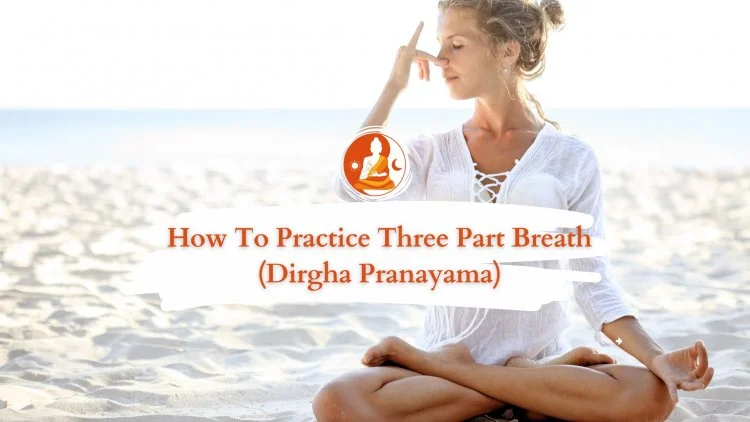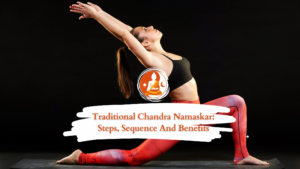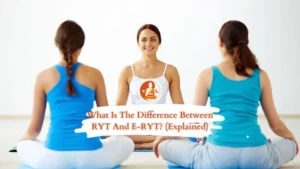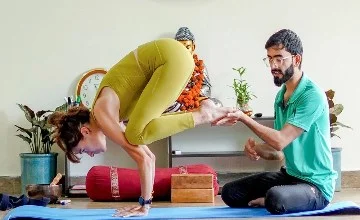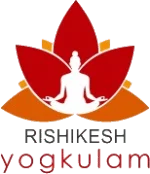Our life in modern times is filled with excessive screen time,not enough physical activity and eating a lot of processed food. These bad habits result in increased stress levels that strain and weaken our breathing patterns over time, leading to chest breathing.
Breathing through the chest limits the range of motion of the diaphragm and increases anxiety. Number of studies have indicated that deep breathing through diaphragm reduces stress levels. Additionally these practices positively influence our moods and bring lots of other health benefits.
Here comes the three part yoga breathing also known as Dirgha Pranayama.what makes Dirga pranayama particularly appealing is that its simplicity even by practicing the basic steps, can improve your health and overall well being. Dirga can be practiced by anyone even if you don’t have any experience in yoga.
Table of Contents
ToggleWhat is Dirga Pranayama?
Dirga Pranayama is also known as the three part breath. It is a yoga breathing technique that involves slow and deep breathing while filling the abdomen, chest, and clavicular(upper chest) region. This ‘three-part’ technique is a form of integrative training developed to 1) prolong breathing, 2) use your full lung capacity, and 3) build a body-breath-mind connection.
These three parts of the practice refers to the abdomen, chest, and upper chest. Dirgha pranayama makes you familiar with the three chambers of the lungs and the mechanism of breathing. A good deep breath involves the following –
- Diaphragmatic breathing (the abdomen)
- Thoracic breathing (the chest)
- Clavicular breathing (collar bones or upper chest)
There are many health benefits of practicing Dirgha pranayama regularly such as reducing stress, increasing mental focus and improving breathing habits.
Dirgha Pranayama Meaning?
In yoga, Dirga Pranayama means Three part breath. The word Dirgha in Sanskrit refers to ‘long in time ‘. Prana means “life force”; and yama means “restraint,” or ayama means “extend”. Therefore, Dirga Pranayama simply means to lengthen the space and time of the breath.
Additionally “Dirgha” also means “ deliberate”. By practicing deliberate breathing, the practice of Dirga Pranayama enhances your awareness of breath. In other words, Dirga Pranayama is an excellent resource to deepen your experience with prana and develop a mind-breath connection which is also the foundation of advanced yoga practices.
Steps of Three Part Breath:
- Difficulty Level: Beginner
- Recommended Poses: Corpse or Easy Pose
- Duration: 15 Breaths
How to Practice Three Part Breath?
First part: Inhale through your nose and allow your belly to expand softly as the breath moves into your lungs. Then exhale through your nose while contracting your abdominal muscles, pull your belly button toward your spine, and allow as much air as possible to escape from your lungs.
Second part: Second part is almost the same, with an added step. Continue to Inhale through the nose and allow your belly region to expand, and while allowing the breath to expand your chest as well. When you exhale through the nose, squeeze all the air out of your chest and belly until it is completely empty.
Third Part: Here you need to take the practice one step ahead. Continue to Inhale through the nose while allowing your belly to expand as the breath moves into your lungs and chest.Then draw the breath into your upper chest towards your pectoral muscles and clavicle. Finish the process by exhaling completely.
Step One: How to Prepare?
To start, sit into any comfortable cross-legged yoga posture. place your right hand on your stomach and your left hand on your chest. close your eyes and perform gentle and even breathing for one to two minutes.focus on your breath and minimize all the external distractions.
Step Two: How to Breath through the diaphragm
Start by inhaling deeply into your diaphragm and allow your lower belly to expand full. As you exhale, try to contract your abdominal muscles and pull your belly towards your spine. Try to expel as much air as possible from the lungs without straining.
Step Three: Include thoracic breathing
Step two is to take a deep inhale to allow your abdomen to expand fully,then let the air continue to expand your thoracic region around your rib cage. As you exhale through your nose, try to squeeze the air out of your rib cage and belly until they’re empty.
Step Four: Three-part breath – Dirga Pranayama Practice and Benefits:
Here comes the third and final step. While you inhale, make sure that your abdomen expands followed by your rib cage.allow the breath to continue upward filling the upper chest around the pectorals muscles. Please note that there is no breath retention in Dirga pranayama and mastering of the three-part breath is attained when you can do it with an even, smooth, and continuous flow of breath.
Benefits of Dirga Pranayama:
Dirga Pranayama promotes breathing through Diaphragm and increases the oxygen in the blood. Many scientific studies have shown that diaphragmatic breathing significantly influences mood and the stress relaxation response of the body. Dirgha pranayama is highly beneficial to relax the body and mind when preparing for yoga and meditation.
There are also other well-known benefits of the three part breath such as lowering blood pressure and maintaining heart rate. Some of the yoga texts suggest that it stimulates the metabolic fire and leads to improved digestion. Dirga pranayama can also provide relief with insomnia or many different sleep disorders.
Three Part Breath: It’s Contraindications and Precautions
This practice of three-part breath is considered safe for everyone. However, pregnant women, those with respiratory problems such as asthma, bronchitis, patients recovering from a serious illness, and those suffering from chronic conditions such as cardiovascular disease are advised to consult their physician before practicing Dirga pranayama in their Yoga practice.
As the pranayama is always done on an empty stomach. We suggest everyone to wait for at least 3 hours after a meal before attempting Dirgha pranayama. Make sure to practice it in a well-ventilated space. Also, Pollution, incense sticks, fumes, or poor ventilation are not very good for this practice and may even be harmful.

